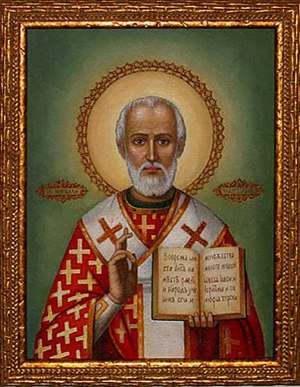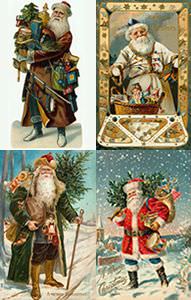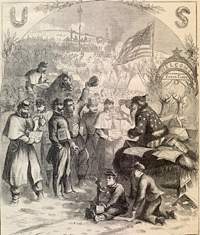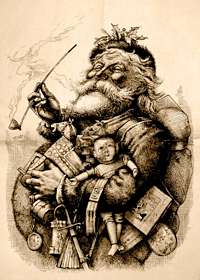We all know what Christmas is supposed to symbolize, but how did it get it's start? When did it become a national holiday? Where and when did Santa enter the picture?
The following articles break it down for us:
The Rise of Christmas as a National Holiday in America
By: Travis DodgeOn June 28th, 1870, President Ulysses S. Grant signed the bill to make Christmas a legal holiday in the United States of America. Also on the bill was the declaration of the 4th of July and Thanksgiving as holidays as well. It was originally introduced into the House of Representatives by Rep. Burton Chauncey Cook of Illinois.
Christmas had been celebrated by Christians as early as 354 A.D., but was mostly a communal feast to celebrate the birth of Jesus Christ on December 25th. This days was chosen during the 4th century by Church leadership in Rome because it was the date of the Southern Solstice, because of it's "cosmic symbolism."
Christmas first came to America along with the British Colonialists, although many of the Puritan leaders disapproved of the holiday. After the American Revolution, the holiday dropped in popularity due to it being seen as an English custom. However, in the 1820s a public interest in Christmas was revived by Washington Irving's short stories in his books The Sketch Book of Geoffrey Crayon and Old Christmas, where he recounts Christmas traditions. In 1822, Clement Clarke Moore wrote the poem A Visit From St. Nicolas, more popularly known by it's first line: 'Twas the night before Christmas. This is the point when Christmas first became associated with commercialism and the annual purchase of gifts. With the publishing of Charles Dickens's novel A Christmas Carol in 1843, it's popularity as a holiday of good will and generosity began to rise.
Christmas had reached a new high in popularity in the 1870s, prompting the 18th President of the United States to sign it into law as a holiday. Since then, the holiday seems to have taken on a life of its own. Getting further from the original intention of the day (a recognition and celebration of the birthday of the Christian savior Jesus Christ), Christmas has become a time when humanity is encouraged to set their petty differences aside and to celebrate being with each other with gift-giving.
However, over time, the holiday has become more of a part of the economy than a religious holiday, with it's dramatic increase of people buying presents for each other. It has become the largest annual economic stimulus for many countries around the world. Not the day itself, but the shopping season that leads up to it. Christmas Day in reality is the least active day for business and commerce, seeing as most businesses are closed due to it being a national holiday.
Santa really did exist!!!!!!!!!!!!
A Children's Sermon adapted by the Rev. George Philip Hoy from Calendar of Christianity by Allan Hauck, Association Press
 Postcard, Austria St Nicholas Center Collection |
Saint Nicholas was born in Patara (Asia Minor) and later moved to Myra (Demre in modern Turkey), where he was elected bishop. He died on Dec. 6 sometime between A. D. 326 and 341. Many stories have been told of his generosity.
In Saint Nicholas' time, a young woman had to have a dowry (money or material things which she brought to her husband) before she could be married. It's a custom we have eliminated in our culture because we believe in the equality of women and men. Saint Nicholas wanted to help a poor nobleman with three daughters, but he wanted to do it anonymously (without anyone knowing who did it). He didn't want to be praised for his generosity. He gave for the joy of giving. So, three bags of gold were thrown through the nobleman's window. However, the nobleman found out who had given the gold for his daughters' dowries. After that, anonymous gifts of charity often were attributed to Saint Nicholas.
This good man also spent several years in prison because of his faith. Many prisoners were converted to the Christian faith by his witness.
The stories of Saint Nicholas came to America through the Dutch settlers in the state of New York. He has changed through the years.
Originally, he was dressed in his traditional Bishop's robes. It wasn't until the 20th century that he began to be dressed in the red and white outfit in which he appears to us now in the persons of his many "helpers." In fact, in 1874, the American cartoonist Thomas Nast drew him in a brown suit with brown fur trim.
Dr. Clement C. Moore, a professor of Greek and Biblical Studies at General Theological Seminary of New York, wrote "A Visit from St. Nicholas" (more commonly know as "Twas the Night Before Christmas") in 1822. Only eight reindeer pulled Santa's sleigh until the song "Rudolph, the Red-Nosed Reindeer" was written.
Jesus, the Christ (the Messiah) is the most important person in the Advent/Christmas season. However, since Saint Nicholas conveys a spirit of generosity and love, we remember him and we too give gifts. Because Saint Nicholas gave us such a good example of helping the poor, Santa Claus may well be a healthy part of our celebrations. As Allan Hauck wrote in Calendar of Christianity, If Santa Claus has become too commercial, too secularized, perhaps it is "because we have forgotten his historical origin in the beloved Bishop of Myra who obeyed Christ's command that we help all those who are in need."
The Man Behind the Story of Father Christmas/Santa Claus
St. Nicholas was a Bishop who lived in the fourth century AD in a place called Myra in Asia Minor (now called Turkey). He was a very rich man because his parents died when he was young and left him a lot of money. He was also a very kind man and had a reputation for helping the poor and giving secret gifts to people who needed it. There are several legends about St. Nicholas, although we don't know if any of them are true!
www.stnicholascenter.org
There was a poor man who had three daughters. He was so poor, he did not have enough money for a dowry, so his daughters couldn't get married. (A dowry is a sum of money paid to the bridegroom by the brides parents on the wedding day. This still happens in some countries, even today.) One night, Nicholas secretly dropped a bag of gold down the chimney and into the house (This meant that the oldest daughter was then able to be married.). The bag fell into a stocking that had been hung by the fire to dry! This was repeated later with the second daughter. Finally, determined to discover the person who had given him the money, the father secretly hid by the fire every evening until he caught Nicholas dropping in a bag of gold. Nicholas begged the man to not tell anyone what he had done, because he did not want to bring attention to himself. But soon the news got out and when anyone received a secret gift, it was thought that maybe it was from Nicholas.
Because of his kindness Nicholas was made a Saint. St. Nicholas is not only the saint of children but also of sailors! One story tells of him helping some sailors that were caught in a dreadful storm off the coast of Turkey. The storm was raging around them and all the men were terrified that their ship would sink beneath the giant waves. They prayed to St. Nicholas to help them. Suddenly, he was standing on the deck before them. He ordered the sea to be calm, the storm died away, and they were able to sail their ship safely to port.
St. Nicholas was exiled from Myra and later put in prison during the persecution by the Emperor Diocletian. No one is really knows when he died, but it was on 6th December in either 345 or 352 AD. In 1087, his bones were stolen from Turkey by some Italian merchant sailors. The bones are now kept in the Church named after him in the Italian port of Bari. On St. Nicholas feast day (6th December), the sailors of Bari still carry his statue from the Cathedral out to sea, so that he can bless the waters and so give them safe voyages throughout the year.
You can find out lots about about St Nicholas at the St. Nicholas Center.
How St. Nicholas Became Santa Claus
 In the 16th Century in Europe, the stories and traditions about St. Nicholas had become very unpopular.
In the 16th Century in Europe, the stories and traditions about St. Nicholas had become very unpopular.But someone had to deliver presents to children at Christmas, so in the UK, he became 'Father Christmas', a character from old children's stories; in France, he was then known as 'Père Nöel'; in Germany, the 'Christ Kind'. In the early USA his name was 'Kris Kringle'. Later, Dutch settlers in the USA took the old stories of St. Nicholas with them and Kris Kringle became 'Sinterklaas' or as we now say 'Santa Claus'!
Many countries, especially ones in Europe, celebrate St. Nicholas' Day on 6th December. In Holland and some other European Countries, children leave clogs or shoes out to be filled with presents. They also believe that if they leave some hay and carrots in their shoes for Sinterklaas's horse, they will be left some sweets.
St. Nicholas became popular again in the Victorian era when writers, poets and artists rediscovered the old stories.
In 1823 the famous poem 'A Visit from St. Nicholas' or 'T'was the Night before Christmas', was published. Dr Clement Clarke Moore later claimed that he had written it for his children. However, some scholars now believe that it was actually written by Henry Livingston, Jr., who was a distant relative of Dr Moore's wife. The poem describes eight reindeer and gives them their names. They became really well known in the song 'Rudolph the Red nosed Reindeer', written in 1949. Do you know all eight names? Click on Rudolph's nose to find out!
 Did you know that Rudolph might actually be a girl!? Only female
reindeer keep their antlers throughout winter. By Christmas time most
males have discarded their antlers and are saving their energy ready to
grow a new pair in the spring.
Did you know that Rudolph might actually be a girl!? Only female
reindeer keep their antlers throughout winter. By Christmas time most
males have discarded their antlers and are saving their energy ready to
grow a new pair in the spring.The UK Father Christmas and the American Santa Claus became more and more alike over the years and are now one and the same.
Some people say that Santa lives at the North Pole. In Finland, they say that he lives in the north part of their country called Lapland.
But everyone agrees that he travels through the sky on a sledge that is pulled by reindeer, that he comes into houses down the chimney at night and places presents for the children in socks or bags by their beds, in front of the family Christmas tree, or by the fire place.

Most children receive their presents on Christmas Eve night or early Christmas morning, but in some countries they get their presents on St. Nicholas' Day, December 6th.
St. Nicholas putting the bag of gold into a stocking is probably where the custom of having a tangerine or satsuma at the bottom of your Christmas stocking came from. If people couldn't afford gold, some golden fruit was a good replacement - and until the last 50 years these were quite unusual fruits and so still special!
The biggest Christmas stocking was 51m 35cm (168ft 5.65in) long and 21m 63cm (70ft 11.57in) wide (from the heel to the toe). It was made the volunteer emergency services organisation Pubblica Assistenza Carrara e Sezioni (Italy) in Carrara, Tuscany, Italy, on 5th January 2011. Just think how many presents you could fit in that!
Santa Claus and Coca-Cola

This is definitely NOT TRUE!
Long before coke had been invented, St Nicholas had worn his Bishop's red robes. During Victorian times, he wore a range of colours (red, green, blue and brown fur) but red was always his favourite!
In January 1863, the magazine Harper's Weekly published the first illustration of St Nicholas/St Nick by Thomas Nast. In this he was wearing a 'Stars and Stripes' outfit! Over the next 20 years Thomas Nast continued to draw Santa every Christmas and his works were very popular indeed (he must have been very good friends with Santa to get such good access!).
This is when Santa really started to develop his big tummy and the style of red and white outfit he wears today. Nast designed Santa's look on some historical information about Santa and the poem 'A Visit from St. Nicholas'.

This image of Santa became very popular, with more artists drawing Santa in his red and white costume from 1900 to 1930.
By 1931, when Coke first used Santa in their advertising, his image was well established. The first 'Coke Santa' was drawn by artist Haddon Sundblom. He took the idea of Nast's Santa but made him even more larger than life and jolly, replaced the pipe with a bottle of Coke and created the famous Coke holding Santa!
Coca-Cola also agree that the red suit was made popular by Thomas Nast not them!
No comments:
Post a Comment